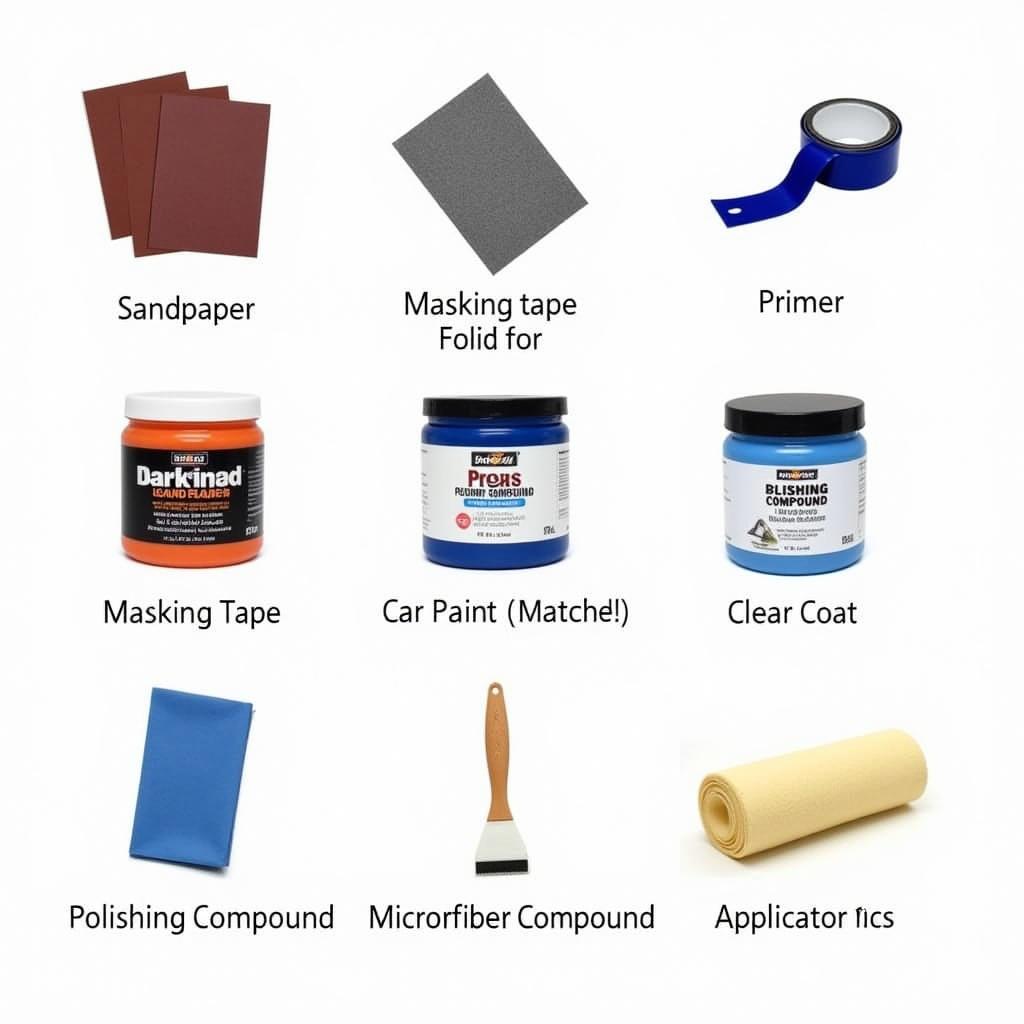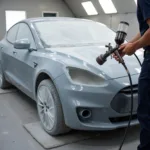Car body paint repair DIY can seem daunting, but with the right knowledge and tools, you can achieve surprising results and save money. This guide provides a comprehensive overview of DIY car paint repair, from assessing the damage to achieving a professional-looking finish.
Understanding the Different Types of Car Paint Damage
Before diving into the repair process, it’s crucial to identify the type of damage. Is it a minor scratch, a deep gouge, a chipped paint area, or perhaps swirl marks from improper washing? Each type of damage requires a slightly different approach. Knowing the extent of the damage will help you determine the necessary tools and techniques for effective car body paint repair diy. Check our car body paint repair guide for more detailed information on various paint damage types.
Gathering Your DIY Car Paint Repair Arsenal
Having the correct tools and materials is essential for successful car body paint repair diy. You’ll need sandpaper (various grits), masking tape, primer, car paint (matched to your car’s color code), clear coat, rubbing compound, polishing compound, microfiber cloths, and applicators. Consider a Dupli Color body paint repair kit car scratch remover for a convenient all-in-one solution for minor scratches.
Essential Tools for Car Body Paint Repair DIY
- Sandpaper: Use a range of grits from coarse to fine for smoothing and preparing the surface.
- Masking Tape: Protects surrounding areas from overspray.
- Primer: Provides a base for the new paint to adhere to.
- Car Paint: Choose the correct color and type (acrylic lacquer, acrylic enamel, or urethane).
- Clear Coat: Protects the paint and adds shine.
 Essential DIY Car Paint Repair Tools
Essential DIY Car Paint Repair Tools
Step-by-Step Guide to DIY Car Paint Repair
- Clean the Damaged Area: Thoroughly wash and dry the area to be repaired. Remove any dirt, grease, or wax.
- Sand the Damaged Area: Start with a coarser grit sandpaper to smooth out any imperfections and gradually move to finer grits for a smooth finish.
- Apply Primer (if necessary): If the damage is deep enough to expose bare metal, apply a thin coat of primer. Let it dry completely.
- Apply the Car Paint: Apply thin, even coats of car paint, allowing each coat to dry before applying the next.
- Apply Clear Coat: Once the paint is dry, apply a few coats of clear coat for protection and shine.
How to Match Your Car’s Paint Color?
Finding the correct paint color is crucial. Your car’s color code can usually be found on a sticker inside the driver’s side doorjamb, glove box, or under the hood. Automotive paint suppliers can mix the paint precisely using this code.
Common Mistakes to Avoid in Car Body Paint Repair DIY
- Rushing the process: Take your time with each step, especially the sanding and painting.
- Applying thick coats of paint: This can lead to drips and uneven drying.
- Not using the correct grit sandpaper: Using sandpaper that is too coarse can damage the surrounding paint.
- Ignoring the importance of surface preparation: Proper cleaning and sanding are crucial for good paint adhesion.
“Proper surface preparation is the key to a professional-looking DIY car paint repair,” says renowned auto detailer, Michael Stevens. “Take your time and ensure the surface is clean and smooth before applying any paint.”
Car Body Paint Repair DIY: Is it Worth It?
DIY car paint repair can be a cost-effective solution for minor damage, such as scratches and chips. However, for extensive damage or if you lack experience, seeking professional help might be the best option. You can find affordable solutions with a cheap car paint repair in Melbourne. Alternatively, a car paint repair scratch pen might be a suitable option for minor touch-ups. For those in Richmond Hill, searching for “car paint repair Richmond Hill” will connect you with local services. Car paint repair Richmond Hill offers various options.
Conclusion
Car body paint repair diy can be a rewarding experience, saving you money and giving you a sense of accomplishment. By following the steps outlined in this guide and avoiding common mistakes, you can achieve impressive results. Remember to be patient, pay attention to detail, and choose the right materials for a successful and long-lasting repair.
FAQ
- Can I repair any type of car paint damage myself?
- What type of paint should I use for my car?
- How do I find my car’s paint code?
- What is the best way to remove scratches from my car?
- How long does it take for car paint to dry?
- How can I prevent future car paint damage?
- What should I do if my DIY repair doesn’t turn out well?
Need assistance? Contact us via WhatsApp: +1(641)206-8880 or Email: [email protected]. Our customer support team is available 24/7.


